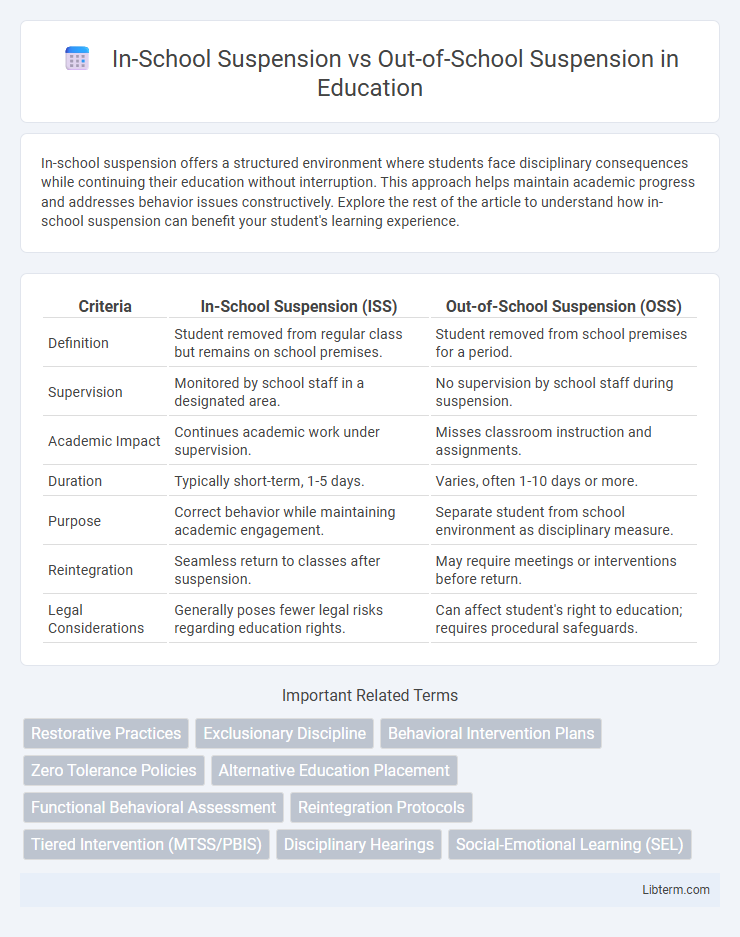In-school suspension offers a structured environment where students face disciplinary consequences while continuing their education without interruption. This approach helps maintain academic progress and addresses behavior issues constructively. Explore the rest of the article to understand how in-school suspension can benefit your student's learning experience.
Table of Comparison
| Criteria | In-School Suspension (ISS) | Out-of-School Suspension (OSS) |
|---|---|---|
| Definition | Student removed from regular class but remains on school premises. | Student removed from school premises for a period. |
| Supervision | Monitored by school staff in a designated area. | No supervision by school staff during suspension. |
| Academic Impact | Continues academic work under supervision. | Misses classroom instruction and assignments. |
| Duration | Typically short-term, 1-5 days. | Varies, often 1-10 days or more. |
| Purpose | Correct behavior while maintaining academic engagement. | Separate student from school environment as disciplinary measure. |
| Reintegration | Seamless return to classes after suspension. | May require meetings or interventions before return. |
| Legal Considerations | Generally poses fewer legal risks regarding education rights. | Can affect student's right to education; requires procedural safeguards. |
Understanding In-School Suspension: Definition and Purpose
In-school suspension (ISS) is a disciplinary strategy where students are removed from their regular classes but remain within the school environment under supervision. Its purpose is to address behavioral issues while allowing students to continue academic work, minimizing disruption to learning. ISS aims to promote accountability and reflection without the negative impacts associated with out-of-school suspension (OSS).
Out-of-School Suspension Explained: Key Features
Out-of-school suspension (OSS) removes students from the school environment for a specified period due to behavioral issues, aiming to provide consequences while maintaining safety. Key features include exclusion from all school activities, loss of on-campus privileges, and continued academic responsibilities through assigned work or online resources. OSS impacts student attendance records and often requires parental notification and a reentry meeting to address behavioral expectations.
Core Differences Between In-School and Out-of-School Suspension
In-school suspension (ISS) requires students to remain within the school environment under supervision, allowing them to continue academic work while isolated from peers. Out-of-school suspension (OSS) temporarily removes students from the school premises, halting their participation in classroom activities and increasing risk of academic disruption. Core differences include ISS's emphasis on maintaining educational engagement and behavior correction within school, whereas OSS prioritizes punitive removal, often leading to increased absenteeism and learning gaps.
Impact on Academic Performance: Comparing Both Approaches
In-school suspension (ISS) maintains students within the academic environment, allowing continued access to coursework and teacher support, which often results in less disruption to learning and better academic performance compared to out-of-school suspension (OSS). OSS removes students entirely from the educational setting, leading to missed instructional time, increased risk of academic decline, and higher dropout rates. Research indicates that ISS is more effective in minimizing negative educational outcomes and supporting student reintegration.
Effects on Student Behavior and Discipline
In-school suspension (ISS) allows students to remain within the educational environment while being separated from regular classes, which helps maintain academic engagement and reduces the risk of falling behind. Out-of-school suspension (OSS) removes students from the school setting entirely, often leading to increased absenteeism, disengagement, and higher dropout rates. Research indicates that ISS tends to promote better behavioral improvement and accountability by providing structured supervision and continuing education, whereas OSS may exacerbate behavioral problems due to lack of support and increased isolation.
Parental Involvement and Communication Strategies
In-School Suspension (ISS) promotes stronger parental involvement through frequent communication between school staff and families, enabling timely updates on student behavior and academic progress. Out-of-School Suspension (OSS) often reduces direct interaction, making strategic outreach essential for maintaining parent engagement and ensuring accountability. Effective communication strategies include scheduled conferences, regular progress reports, and collaborative behavior plans to support students' reintegration and prevent future suspensions.
Equity and Disproportionate Suspension: Addressing Bias
In-school suspension (ISS) and out-of-school suspension (OSS) disproportionately affect students of color, contributing to significant equity challenges within education systems. Research indicates that OSS often leads to increased academic setbacks and heightened disengagement, exacerbating disparities in educational outcomes for marginalized groups. Implementing culturally responsive disciplinary practices and bias training for educators is critical to reducing these inequities and promoting fairer suspension policies.
Long-Term Consequences for Students
In-school suspension allows students to continue their education in a controlled environment, mitigating learning loss and maintaining academic progress, whereas out-of-school suspension removes students from the educational setting entirely, increasing the risk of academic decline and dropout. Research indicates that out-of-school suspension is linked to higher rates of repeat offenses and long-term negative impacts on student achievement and social behavior. Implementing in-school suspension can reduce these adverse outcomes by providing structured support and minimizing disruptions to students' academic and social development.
Alternatives to Traditional Suspension Methods
Alternatives to traditional suspension methods, such as restorative justice programs and in-school suspension (ISS), provide students with opportunities to reflect on their behavior while remaining engaged in their education. Restorative practices promote accountability and reconciliation, reducing recidivism and improving school climate. Research indicates these alternatives enhance student outcomes by maintaining academic continuity and fostering positive social development.
Best Practices for Effective School Discipline Policies
Implementing clear guidelines that differentiate between in-school suspension (ISS) and out-of-school suspension (OSS) ensures students remain engaged academically while addressing behavioral issues. Best practices emphasize restorative approaches during ISS, allowing continued learning and reflection, whereas OSS should be reserved for severe infractions to minimize negative impacts on student outcomes. Data-driven discipline policies incorporating regular review and inclusive stakeholder input promote fairness and improve overall school climate.
In-School Suspension Infographic

 libterm.com
libterm.com